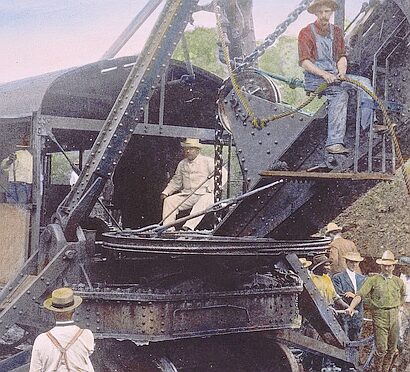The construction of the Panama Canal stands as one of the most significant engineering accomplishments in history, transforming global trade and maritime navigation. This ambitious project would not have been possible without the unwavering determination and visionary leadership of President Theodore Roosevelt. This article explores how Teddy Roosevelt’s strategic vision and political acumen were instrumental in securing the successful completion of the Panama Canal.
The Need for a Transoceanic Passage:
At the turn of the 20th century, the United States recognized the urgent need for a shorter, more efficient route connecting the Atlantic and Pacific Oceans. The existing options, such as the lengthy journey around Cape Horn or the arduous crossing through the Strait of Magellan, posed significant challenges and expenses for international trade. Teddy Roosevelt understood that constructing a canal through the narrow isthmus of Panama would revolutionize global commerce.
Roosevelt’s Diplomatic Maneuvers:
The acquisition of the land necessary to build the canal was the first major hurdle. Roosevelt skillfully negotiated with Colombia, which then controlled Panama, to secure permission for the canal’s construction. When the Colombian Senate rejected the treaty, Roosevelt swiftly recognized Panama’s independence, paving the way for the United States to negotiate directly with the new Panamanian government.
Overcoming Engineering Challenges:
The Panama Canal faced monumental engineering obstacles, including dense jungles, treacherous terrain, and the deadly threat of tropical diseases like malaria and yellow fever. Roosevelt appointed John Stevens as the chief engineer, and later, Army Colonel George Washington Goethals. Their tireless efforts to combat the harsh natural environment and implement innovative engineering solutions ensured the project’s success.
Contributions to Global Trade:
The completion of the Panama Canal in 1914 revolutionized international trade by dramatically reducing travel distances and costs. Ships no longer had to navigate dangerous waters, saving significant time and resources. This new transoceanic passage facilitated the growth of global commerce, enabling goods and resources to flow more efficiently between the Atlantic and Pacific regions.
Legacy and Impact:
Teddy Roosevelt’s vision and determination in completing the Panama Canal left an indelible mark on American history and the world. The canal’s successful construction showcased the United States as a rising global power, capable of taking on monumental engineering challenges. The strategic advantage gained through this triumph bolstered America’s influence and presence in both the Atlantic and Pacific regions.
The completion of the Panama Canal was a testament to Teddy Roosevelt’s unparalleled leadership and strategic thinking. His diplomatic maneuvers, coupled with his unwavering commitment to progress, ensured the successful realization of this engineering marvel. The Panama Canal remains a symbol of Roosevelt’s enduring legacy as a transformative leader who shaped the course of American history while leaving an undeniable impact on global trade and navigation.
